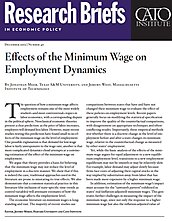We argue that theory provides a basis for believing that the minimum wage may not reduce the level of employment in a discrete manner. We show that if this is indeed the case, traditional approaches used in the literature are prone to misstating its true effects. We also demonstrate that a common statistical practice in this literature (the inclusion of state-specific time trends as control variables) will attenuate estimates of how the minimum wage affects the employment level.
The economic literature on minimum wages is longstanding and vast. The majority of recent studies use comparisons between states that have and have not changed their minimum wage to evaluate the effect of these policies on employment levels. Recent papers generally focus on modifying the statistical specification to improve the quality of the counterfactual comparisons, with disagreement on appropriate techniques and often-conflicting results. Importantly, these empirical methods test whether there is a discrete change in the level of employment before and after a state changes its minimum wage, relative to the counterfactual change as measured by other states’ employment.
Yet, while the basic analysis of the effects of the minimum wage argues for rapid adjustment to a new equilibrium employment level, transitions to a new employment equilibrium may not be smooth or may be relatively slow. For example, labor demand may adjust slowly because firms face costs of adjusting their capital stocks in the way implied by substitution away from labor that has been made more expensive by a higher minimum wage.
In addition, estimation of the minimum wage’s impact must account for the “sawtooth pattern” exhibited in states’ real (inflation-adjusted) minimum wages. This generates further challenges in measuring the impact of the minimum wage, since not only the response to a higher minimum wage but also the inflation-adjusted value of the minimum wage itself might vary over time. Indeed, earlier work has found substantial impacts of minimum wage increases beyond a contemporaneous effect. To be clear, if the true effect of a minimum wage is to change employment over time rather than to have an immediate effect on the employment level, the traditional approaches used in this literature can yield an incorrect inference.
Our analysis uses a number of different empirical approaches to examine effects of the minimum wage on the dynamics of employment, rather than just on discrete changes in levels. We perform numerous robustness checks to test the validity of our identification strategy, which requires that the preexisting time paths of outcomes for states that increase their minimum wages do not differ relative to states that do not see an increase. We evaluate this possibility by adding future values of the minimum wage into our specifications. If increases in the minimum wage showed a negative effect on employment before their implementation, this would suggest that the results are being driven by unobserved trends. This is not the case. Indeed, for our results to be driven by confounders, one would have to believe that increases in the minimum wage were systematically correlated with unobserved shocks to that state in the same time period, but not other states in that region, and that these shocks are not reflected in measures of state-specific demographics or business cycles. Our primary results are additionally robust to varying the specifications to account for finer spatial and temporal controls, the recent financial crisis, and inflation indexing of state minimum wages.
We use three administrative data sets in our analysis: the Business Dynamics Statistics (BDS), the Quarterly Census of Employment and Wages (QCEW), and the Quarterly Workforce Indicators (QWI). These data sets vary in their strengths and weaknesses, discussed at length below, but together they encompass a long (1975–2012) panel of aggregate employment metrics for the population of employers in the United States. Our findings are consistent across all three data sets, indicating that employment declines significantly in response to increases in the minimum wage over the span of several years; we find that a 10 percent increase in the minimum wage causes a reduction in total employment of about 0.8 percent over this timespan. Since the effects are concentrated on lower-skilled workers, the impact on the employment of those individuals is much higher.
If the minimum wage is to be evaluated alongside alternative policy instruments for increasing the standard of living of low-income households, a more conclusive understanding of its effects is necessary. The primary implication of our study is that the minimum wage does affect employment through a particular mechanism. This is important for normative analysis in theoretical models and for policymakers weighing the tradeoffs between the increased wage for minimum wage earners and the potential reduction in hiring and employment. Moreover, we reconcile the tension between the expected theoretical effect of the minimum wage and the estimated null effect found by some researchers. We show that because minimum wages reduce employment levels through dynamic effects on employment growth, research designs incorporating state-specific time trends are prone to erroneously estimated null effects on employment.
Our work, of course, does not settle the debate of a contentious topic, but we shed light on the mechanisms by which the minimum wage affects employment and provide directions for future research delving more deeply into the dynamics of this relationship.
Note
This research brief is based on Jonathan Meer and Jeremy West, “Effects of the Minimum Wage on Employment Dynamics,” Journal of Human Resources, forthcoming, 2016.
